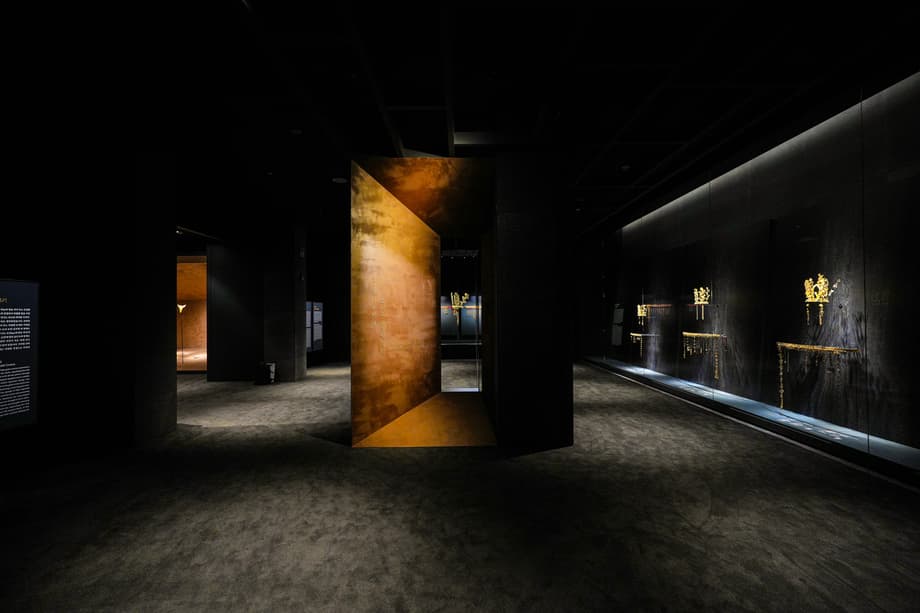A rare reunion draws crowds and a cap
Gyeongju National Museum has set strict daily entry limits after opening a landmark exhibition that reunites all six surviving gold crowns from the Silla Kingdom for the first time. Titled Silla Gold Crowns: Power and Prestige, the show launched to long lines outside the museum before doors opened at 10 a.m., a sign of the intense public interest in this once in a century gathering. To keep the galleries safe and comfortable, the museum is admitting 150 visitors per timed session at 30 minute intervals, with a weekday cap of 2,550 people. Numbered tickets are distributed on site starting at 9:20 a.m. The exhibition brings together crowns usually held by different institutions around Korea, along with gold belts and other royal adornments. It runs through Dec. 15 in Gyeongju, the ancient capital of Silla.
The six crowns on display are among the most celebrated artifacts from Korea’s Three Kingdoms period. They were excavated from royal tombs in and around Gyeongju during the 20th century. The crowns appear beside related regalia, including six gold belts, earrings, bracelets, and rings, creating a compact portrait of Silla’s royal splendor. The show is presented as a cultural centerpiece alongside the APEC 2025 schedule in Gyeongju, and it also marks a milestone year for the museum. The gathering allows visitors and scholars to study differences in construction, ornament, and symbolism across the set, an opportunity that has never existed inside a single gallery.
Interest in the crowns has been heightened by recent diplomatic events. South Korea’s President Lee Jae Myung presented a replica of the famed Cheonmachong crown to United States President Donald Trump during APEC week, drawing fresh global attention to Silla’s gold tradition. The original crown remains in Gyeongju for the exhibition, alongside other masterworks that rarely share the same room.
Why visitor limits are in place
Timed entry manages crowding while protecting fragile artifacts. The museum has separated routes for the permanent collection and the special exhibition, and staff are pacing admissions to prevent congestion around the vitrines. Attendance surged from the first morning, with lines forming well before opening. Some visitors arrived before dawn to secure an early time slot. The museum apologized for inconvenience while stressing that the measures are intended to protect visitor safety and to maintain a clear view of each object inside the low light gallery.
The session format also supports object conservation. Gold and jade tolerate controlled light and stable interior conditions, but heavy foot traffic can raise temperature and humidity. Time slots help hold those levels steady. With each group capped at 150, most visitors can approach the display cases without jostling, which improves both the viewing experience and the environment for the artifacts.
Six crowns together for the first time
The exhibition presents an unprecedented chance to see the full arc of Silla crown design in one visit. The six crowns come from tombs that include Geumgwanchong, Geumnyeongchong, Seobongchong, Cheonmachong, Hwangnamdaechong, and Gyo dong. Fourteen of the twenty items on view carry state designation, including several National Treasures and Treasures. Side by side, the crowns reveal a living tradition rather than a fixed template. Some retain austere lines and sparse ornament, while others expand into taller, wider forms with dense pendants and more elaborate surface work.
Geumgwanchong and the birth of a royal symbol
The first Silla gold crown came to light in 1921 at Geumgwanchong during construction work in Noseo dong. Made in the fifth century, it is often called the most representative example. Its headband supports three upright ornaments shaped like tree branches and two uprights shaped like deer antlers. These forms are widely understood as signs of transcendence and sovereignty, expressing a link between the earthly realm and the heavens. The crown includes jade gogok, the comma shaped beads found on many Silla gold objects. The site also yielded a remarkable quantity of gold. The total weight of gold recovered from Geumgwanchong is about 7.5 kilograms, a measure of the wealth invested in Silla burials.
Cheonmachong, height of splendor
Excavated in 1973, the Cheonmachong crown is a National Treasure and one of the largest and widest of the set, dated to the early sixth century. It is richly adorned with dangling leaf like pendants and numerous jade beads. In the same tomb, archaeologists found earrings, bracelets, rings, and belts, all demonstrating the court’s taste for bright metal at the peak of royal ceremony. The crown’s silhouette, with tall uprights and delicate chains, shows the evolution from earlier, simpler patterns to a more formidable ceremonial form.
Gyo dong and the early form debate
The Gyo dong crown entered the museum after being confiscated from a looter in 1969. Because it differed from typical Silla crowns and lacked clear excavation context, its authenticity was debated for years. Excavations at Bokcheon dong in Busan later revealed similarly shaped gilt bronze headpieces, which helped scholars see the Gyo dong crown as an early, simple version in the Silla tradition. Even now it has not been designated as cultural property because of the illegal excavation, but it is invaluable for understanding the origins of the crown type.
Other crowns with distinct features
The crown from Seobongchong includes a dome shaped inner cap topped with small bird ornaments, a detail not shared by the others on display. The Geumnyeongchong crown is smaller and lighter, and it lacks heavy strings of jade, which suggests it may have been made for a younger royal. The crown from Hwangnamdaechong is often linked with a queen, in part because of its paired gold belts including a piece inscribed as a lady’s belt. Together, the set charts subtle change across roughly a century of Silla craftsmanship.
What the crowns say about Silla power
Silla’s royal regalia projected authority, spiritual sanction, and prosperity. The branch shaped uprights can be read as sacred trees that connect sky and earth, a motif known across ancient Northeast Asia. The antler forms suggest shamanic power and the ability to move between worlds. Gokok beads, in pale green and blue shades, signaled life force and status. Gold belts completed the outfit, with attached tools and ornaments that implied rank and court function. In early Silla, rulers held the title maripgan, prior to the adoption of kingly titles, and material splendor served as visible proof of their standing.
Historical descriptions help explain why Silla became known as the Golden Kingdom. UNESCO has noted that even a ninth century Persian geographer, Ibn Khordadbeh, wrote of Silla’s rich gold and its trade. When Silla unified the peninsula in 668, the court in Gyeongju entered a period of vigorous cultural exchange. Buddhism flourished, artisans refined techniques, and goldwork reached extraordinary precision.
Craftsmanship behind the glitter
What looks effortless in the display cases required advanced metalworking. Silla gold crowns are typically made from thin sheet gold that was cut, incised, and sometimes openworked into leaf, tree, and antler patterns. Artisans added tiny chains, leaf pendants, and jade beads to catch light with gentle movement. Specialists also used granulation, sometimes called filigree granulation, which is the process of attaching tiny gold granules and fine wires to create intricate surface patterns. This technique requires precise heating so that the granules bond without collapsing the thin gold sheet underneath.
Pure gold bends easily, so Silla crown makers used gold alloyed with silver to strengthen uprights and bands. The balance varied by piece and over time as the crowns grew taller and more ornate. Gilt bronze headpieces found in Busan and other sites show that bronze models also existed, possibly as earlier forms or different ranks. Silla goldsmiths worked across this range with a consistent eye for geometry, symmetry, and rhythmic repetition. The results, seen up close, are both technically demanding and visually delicate.
A cultural moment tied to APEC
The museum is using this reunion to promote Korean heritage to a global audience during a major diplomatic week in Gyeongju. The timing with APEC 2025 positions the crowns as ambassadors for a deeper story about the region’s past. The recent presentation of a gold crown replica to United States President Donald Trump by President Lee Jae Myung underscored that message. The gift referenced the Cheonmachong masterpiece and invited attention to the original, now a centerpiece of the exhibition. The museum has framed the show as a platform for cultural exchange that connects Gyeongju and the wider world.
For many visitors from abroad, the crowns also offer a clear route into Silla history. The kingdom lasted nearly a millennium (57 BCE to 935 CE), and Gyeongju’s tombs and temples still anchor that story in the landscape. Seeing the regalia collected in a single room compresses centuries of art, religion, and court life into a direct encounter.
How to plan a visit
Tickets are free and distributed on site beginning at 9:20 a.m. Each viewing session admits 150 people, with a weekday cap of 2,550 and more sessions on weekends. Visitors enter on a timed schedule every 30 minutes. The museum opens at 10 a.m., but lines often form much earlier. If your schedule is flexible, arriving before distribution begins offers the best chance at preferred time slots. The museum has routed traffic so that the special exhibition and permanent galleries remain distinct, which helps reduce bottlenecks once you are inside.
Photography rules, bag policies, and flow controls can change based on crowd conditions. Give yourself extra time between sessions in case you need to queue for the next room. The gallery uses low lighting to protect the metal and jade, which also heightens the crowns’ shimmer. Patience pays off, since the details that reveal Silla’s skill show best at close range.
Why this reunion matters to scholarship
Bringing the six crowns together allows researchers to refine the timeline of design changes and to test ideas about rank and ritual. Side by side, the early, simpler forms can be compared against later, more complex ones. Details like the number and height of uprights, the shape of leaf pendants, the density of gogok beads, and the use of inner caps all contribute to a clearer picture of sequence and function. The Gyo dong crown’s acceptance as an early type gained support when similar headpieces were excavated scientifically in Busan. This exhibition lets those connections be seen in person.
Context also matters for understanding how Silla’s gold crowns eventually disappeared from use. As Buddhism took firmer root in the mid sixth century, royal patronage shifted toward temple building and religious image making. Gold moved from crowns to reliquaries, ornaments, and statuary. The regalia seen here capture a moment when sacred power and political order were expressed through shimmering metal worn on the body. That visual language faded as a new religious language took hold, leaving the crowns to slumber in tombs until modern excavation brought them back to light.
Key Points
- Gyeongju National Museum is capping entry to the exhibition Silla Gold Crowns: Power and Prestige, admitting 150 people per 30 minute session.
- Weekday attendance is limited to 2,550, with tickets distributed on site from 9:20 a.m. and additional sessions scheduled on weekends.
- The show reunites all six surviving Silla gold crowns for the first time, alongside related regalia including six gold belts.
- Twenty artifacts are on view, fourteen of them state designated as Treasures or National Treasures.
- Crowns on display were excavated from Geumgwanchong, Geumnyeongchong, Seobongchong, Cheonmachong, Hwangnamdaechong, and Gyo dong tombs.
- The exhibition runs through Dec. 15 in Gyeongju and coincides with APEC 2025 and the museum’s anniversary year.
- A replica of the Cheonmachong crown was presented to United States President Donald Trump by President Lee Jae Myung during APEC week.
- Timed entry and split visitor routes are designed to protect objects, manage crowds, and maintain a clear viewing experience.




